A few years ago (July 10, 1941) I was born in Albert Lea, Minnesota, where I grew up, went to K-12 school, and played music (clarinet, saxophone, and flute) until going off to college. I received the B.A. (1964) and M.A. (1966) degrees in Historical Musicology and Flute Performance from the University of Minnesota, followed by the Ph.D. in Ethnomusicology from the University of California, Los Angeles (1973). I began teaching in the School of Music at the Florida State University in 1973, and retired in 2008 as Distinguished Research Professor of Ethnomusicology in the College of Music. I am now Professor Emeritus.
Between my Minnesota and California life experiences, my wife, Diane (we were 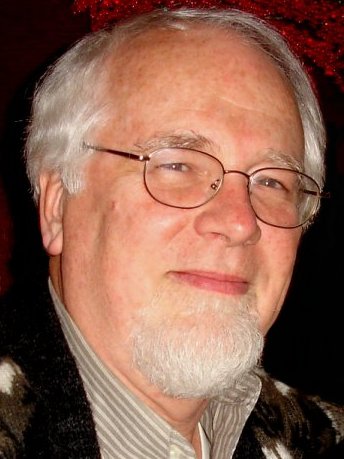 married in 1965), and I lived in Santiago, Chile as Peace Corps Volunteers. As a PCV I was principal flutist with the Philharmonic Orchestra of Chile (1966-68). What a wonderful experience that was, rehearsing and playing symphonic concerts weekly in the beautiful Teatro Municipal in Santiago. I also played in a woodwind quintet made up of the principal wind players. Diane and I traveled nearly everywhere in Chile, and I conducted research at a number of religious folk festivals in the northern part of the country. During and after the Peace Corps, we traveled throughout South America. Some of the geographical highlights of those travels included Patagonia and Tierra del Fuego, Iguazu Falls, Machu Picchu, part of the upper Amazon River, Brazil (Manaus, Brasilia, Belo Horizonte, Rio de Janeiro, Sao Paulo, Curitiba, Salvador, Recife, Belem, and more), and Trinidad and Tobago.
married in 1965), and I lived in Santiago, Chile as Peace Corps Volunteers. As a PCV I was principal flutist with the Philharmonic Orchestra of Chile (1966-68). What a wonderful experience that was, rehearsing and playing symphonic concerts weekly in the beautiful Teatro Municipal in Santiago. I also played in a woodwind quintet made up of the principal wind players. Diane and I traveled nearly everywhere in Chile, and I conducted research at a number of religious folk festivals in the northern part of the country. During and after the Peace Corps, we traveled throughout South America. Some of the geographical highlights of those travels included Patagonia and Tierra del Fuego, Iguazu Falls, Machu Picchu, part of the upper Amazon River, Brazil (Manaus, Brasilia, Belo Horizonte, Rio de Janeiro, Sao Paulo, Curitiba, Salvador, Recife, Belem, and more), and Trinidad and Tobago.
Since those nearly three years in Chile, I have lived, worked, and done research in South America as a Clifton Webb Awardee to Venezuela, National Endowment for the Humanities scholar in Venezuela and Colombia, a Fulbright scholar to Peru, a Florida State University Developing Scholar awardee to Brazil, several times a COFRS awardee to Argentina, Bolivia, Brazil, and Paraguay, and sabbatical researcher in Brazil and Bolivia. I have also received grants and other funds to conduct research in Italy, China, Korea, Tonga (South Pacific), Japan, Ireland, Vietnam, Thailand, and Panama. I have taught overseas in FSU’s International Program in Florence, Italy; Ho Chi Minh City, Vietnam; and Panama City, Panama. In 2005-06 I was awarded a Guggenheim Memorial Fellowship to finish a book on the popular music of Vietnam (see “Books”).
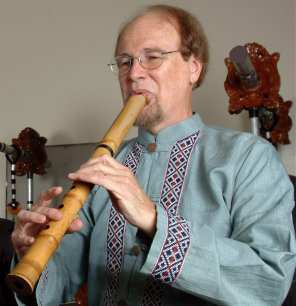 Over the years, and since my days in the Peace Corps in Chile, I learned how to play numerous musical instruments from the Andes (kena, siku, tarka, charango, and the Peruvian indigenous harp). At UCLA I studied the Japanese shakuhachi (in this picture I am playing shakuhachi in front of FSU’s gamelan gong kebyar) and ryuteki with Mitsuru Yuge. I earned a shihan diploma in Kinko-ryu shakuhachi in 1983 from my Japanese sensei, Iwami Baikyoku IV, in Sao Paulo, Brazil (several of my shakuhachi performances and others by Iwami-sensei can be heard in the Audio Files for my book, The Chrysanthemum and the Song [see “books”]).
Over the years, and since my days in the Peace Corps in Chile, I learned how to play numerous musical instruments from the Andes (kena, siku, tarka, charango, and the Peruvian indigenous harp). At UCLA I studied the Japanese shakuhachi (in this picture I am playing shakuhachi in front of FSU’s gamelan gong kebyar) and ryuteki with Mitsuru Yuge. I earned a shihan diploma in Kinko-ryu shakuhachi in 1983 from my Japanese sensei, Iwami Baikyoku IV, in Sao Paulo, Brazil (several of my shakuhachi performances and others by Iwami-sensei can be heard in the Audio Files for my book, The Chrysanthemum and the Song [see “books”]).
I have over 300 wind instruments in my personal musical instrument collection, and I recently finished cataloging and photographing all of my flutes and other aerophones. I hope to find a museum home for them before too long. I play most of them, and used some of them to demonstrate several flutes that I write about in my book titled World Flutelore: Folktales, Myths, and Other Stories of Magical Flute Power.
Diane and I have had great fun playing music together over the years, mostly with Diane on piano or harpsichord and I on silver flute or any one of my recorders (soprano, alto, and tenor). In our retirement we are always working on many types of music, which we enjoy performing for friends.
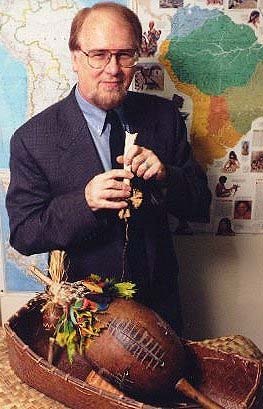 In the academic world as a university professor, we moved directly from UCLA after I received my Ph.D. in music (under Drs. Mantle Hood in ethnomusicology and Johannes Wilbert in anthropology) to Florida State University. For this photograph I posed in my office in the College of Music at Florida State University with several Warao musical instruments, such as the muhusemoi deer-bone flute and the large hebu mataro shamanistic rattle.
In the academic world as a university professor, we moved directly from UCLA after I received my Ph.D. in music (under Drs. Mantle Hood in ethnomusicology and Johannes Wilbert in anthropology) to Florida State University. For this photograph I posed in my office in the College of Music at Florida State University with several Warao musical instruments, such as the muhusemoi deer-bone flute and the large hebu mataro shamanistic rattle.
In the area of academic service, I served as a Council and Board Member at Large of the Society for Ethnomusicology (SEM), as Board Member for Ethnomusicology/World Music of the College Music Society (CMS), as First Vice-President of the Society for Ethnomusicology, as President of The College Music Society from January 1999 through December 2000, as President of the Florida Folklore Society (FFS), and several times as President of the Southeast/Caribbean Chapter of the Society for Ethnomusicology (SEMSEC).
In the academic world of scholarly presentations (always an important activity for university professors), I have participated in many regional, national, and international meetings of AAA (American Anthropological Association), CMS, FFS, ICTM (International Council for Traditional Music), and SEM, traveling with Diane to Japan, Ireland, Costa Rica, Spain, and Thailand (CMS international conferences); Austria, Sweden, Finland, and Newfoundland, Canada (ICTM); and Canada and Mexico (SEM).
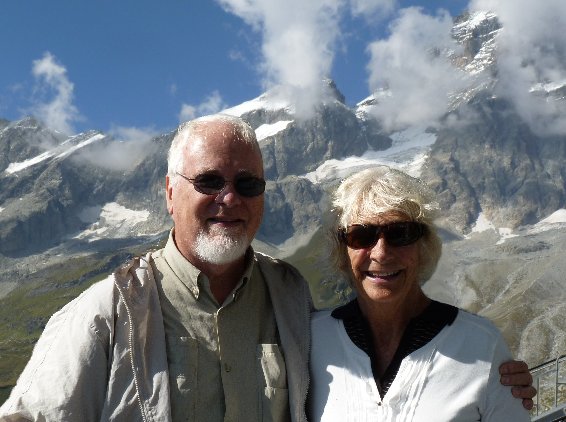 During the summer of 2013 I presented an invited paper in French at a French-speaking conference in southern France (Aubrac, Aveyron). We began our summer by taking an 8-day river cruise on the Seine, from Paris to Giverny, Vernon, Rouen, Normandy, and other spots along the way–then cruising back to Paris where we stayed another week. The conference organizers provided for us to fly to Rodez from Paris, and they drove us to Aubrac, a beautiful medieval village at a crossroads that is on the pilgrimage trail that ends in Santiago de Compostela in Galicia, Spain. After the conference we went to Provence, spending time in Avignon, Arles, and Aix en Provence. Then we went to northern Italy, visiting and hiking in Cinque Terre for a week and staying in Aosta in northern-most Italy. This picture is of Di and me in the Alps, with Cervino (Matterhorn) in the background. In October I translated my French paper into Spanish and presented it as an invited speaker at an international musicology conference in Loja, Ecuador. While in Ecuador we visited Cuenca, the Galápagos, Quito, Otavalo, and more. For more information about some of our recent travels, please link to the section at the bottom of the page titled “Travels.”
During the summer of 2013 I presented an invited paper in French at a French-speaking conference in southern France (Aubrac, Aveyron). We began our summer by taking an 8-day river cruise on the Seine, from Paris to Giverny, Vernon, Rouen, Normandy, and other spots along the way–then cruising back to Paris where we stayed another week. The conference organizers provided for us to fly to Rodez from Paris, and they drove us to Aubrac, a beautiful medieval village at a crossroads that is on the pilgrimage trail that ends in Santiago de Compostela in Galicia, Spain. After the conference we went to Provence, spending time in Avignon, Arles, and Aix en Provence. Then we went to northern Italy, visiting and hiking in Cinque Terre for a week and staying in Aosta in northern-most Italy. This picture is of Di and me in the Alps, with Cervino (Matterhorn) in the background. In October I translated my French paper into Spanish and presented it as an invited speaker at an international musicology conference in Loja, Ecuador. While in Ecuador we visited Cuenca, the Galápagos, Quito, Otavalo, and more. For more information about some of our recent travels, please link to the section at the bottom of the page titled “Travels.”
 I have always enjoyed doing fieldwork research and writing. I have more than 100 publications, including 7 books. One of my recent books is titled Popular Music of Vietnam: The Politics of Remembering, the Economics of Forgetting, for which I did fieldwork during three summers in Vietnam while teaching in and directing FSU’s summer program. In the summer of 2005, while on a Guggenheim fellowship to complete my research for finishing my book, I played weekly with a Vietnamese jazz combo at the Sofitel Hotel in downtown Ho Chi Minh City (this photo).
I have always enjoyed doing fieldwork research and writing. I have more than 100 publications, including 7 books. One of my recent books is titled Popular Music of Vietnam: The Politics of Remembering, the Economics of Forgetting, for which I did fieldwork during three summers in Vietnam while teaching in and directing FSU’s summer program. In the summer of 2005, while on a Guggenheim fellowship to complete my research for finishing my book, I played weekly with a Vietnamese jazz combo at the Sofitel Hotel in downtown Ho Chi Minh City (this photo).
I continue to play jazz and world music whenever there are opportunities. Several years ago I performed a number of gigs with one of my former ethnomusicology students, Carlos Odria, the finest jazz guitarist with whom I have ever played. The following video is one piece (“Flute Music in the Wind”) from a 2014 performance in Tallahassee in which I related various world flutes to some of the folkloric content that I published in one of my recent books, World Flutelore: Folktales, Myths, and Other Stories of Magical Flute Power.
In addition to writing books, I have also edited a number of publications, such as Music of Latin America (Study Guide in series “Sounds of the World”); Volume 2 of The Garland Encyclopedia of World Music coedited with Dan Sheehy; The Garland Handbook of Latin American Music coedited with Dan Sheehy; and I was Recording Review Editor for the journal Ethnomusicology for several years. I have also written many book chapters, and a number of my articles have appeared in the Journal of the American 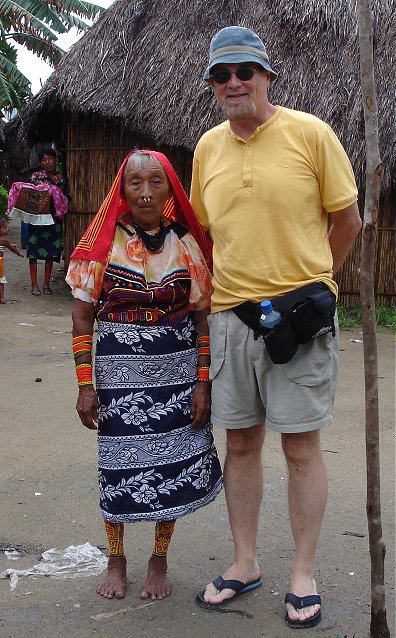 Musical Instrument Society, Asian Music Journal, Ethnomusicology, Latin American Music Review, College Music Symposium, Journal of Latin American Lore, Worlds of Music, and elsewhere (please see my CV).
Musical Instrument Society, Asian Music Journal, Ethnomusicology, Latin American Music Review, College Music Symposium, Journal of Latin American Lore, Worlds of Music, and elsewhere (please see my CV).
I spent the summers of 2006, 2007, and 2008 in Panama, teaching at the FSU-Panama campus in Panama City. While living there I traveled throughout much of the country doing research about the music of Panama (this picture was taken in a Kuna village in the San Blas Islands in 2007).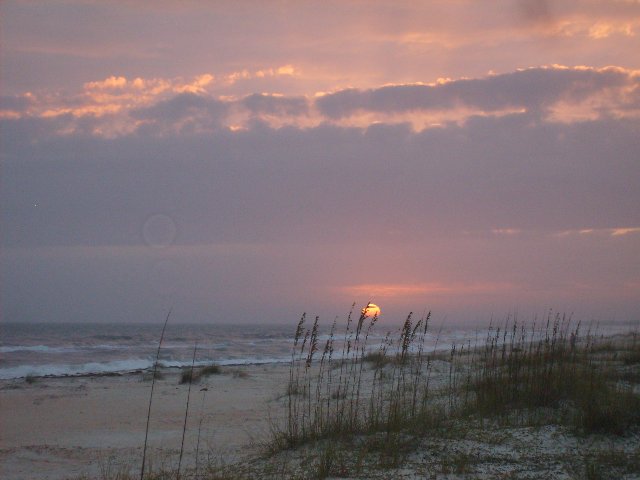
At the personal level, Diane and I have been married 56 years. We have spent many wonderful months at our beach house on St. George Island, Florida, enjoying sunsets and the beauty of the beach and the Gulf of Mexico (this picture is from the front of our beach house).
Diane has her Ph.D. in Instructional Design and worked for the state Department of Education, Department of Children and Families, and the Department of Revenue (she is now retired). She is an avid reader, a fine pianist and harpsichordist, a swimmer and hiker, and a great intellect; she belongs to several book clubs and women’s professional and social groups; she taught English as a second language (preparation for the TOEFL exam) at our church (First Baptist Church of Tallahassee) for many years. Together we enjoy so many things: traveling, hiking, canoeing, sailing, and so much more. God has truly blessed us, not only by giving us each other, but by having so many wonderful friends.
Our son Darin has a bachelor’s degree in architecture and a master’s degree in building construction management from the University of Florida. He has been working for many years in the Atlanta area as a project manager and estimator for several large construction companies. He enjoys mountain biking, sailing, playing guitar, beating his mom and dad in Scrabble, and spending as much time as he can with his beautiful daughters, Isabella and Emma. Darin is married to a beautiful and wonderful woman, Larrie, and has acquired a beautiful stepdaughter, Emma, age 15.
The picture of Darin, Diane, and me, was taken many years ago from the deck of our beach house, “Dunescape,” on St. George Island, Florida. Dunescape is one of my favorite places on earth. It is my writing, reading, and relaxing retreat, although when I have the time to go there, I usually end up repairing things. The salt air has a way of making material objects in need of fixing–but I love it! Below is a beautiful St. George sunset taken from the beach in front of Dunescape. (Please watch the following short movie, which was my first attempt with MovieMaker; the music is an excerpt from “La Mer” by Debussy. )
We have a beautiful 18-year-old granddaughter, Isabella, pictured jumping in the waves at St. George Island, Florida when she was 5 or 6, and second, doing a handstand on the same beach when she was 9. Isabella loves the beach at St. George Island, collecting critters, building sand castles, chasing sea gulls and crabs, floating in the water, and playing in the waves. Thankfully, she is a wonderful swimmer. In addition to the beach, she has enjoyed hiking, riding her bicycle, horseback riding, sailing with her dad, climbing trees, playing games on her ipad, drawing, painting and sculpting, playing soccer, collecting insects, petting lizards and frogs, writing little stories, spending lots of time with her stepsister, Emma and other girls her age, and much more. 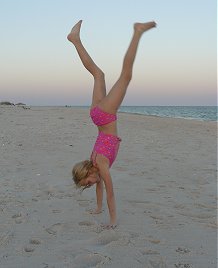
Finally, one of my joys during my retirement has been designing and building a Japanese garden in our heavily wooded backyard on a sloping hill. A three-tiered waterfall and fishpond is the focal point of our new circular patio. I include two pictures of it here: the first was taken during the first year after the waterfall was built in 2009, and the second about three years later in 2012. In the second picture you can see the Japanese bridge I built. 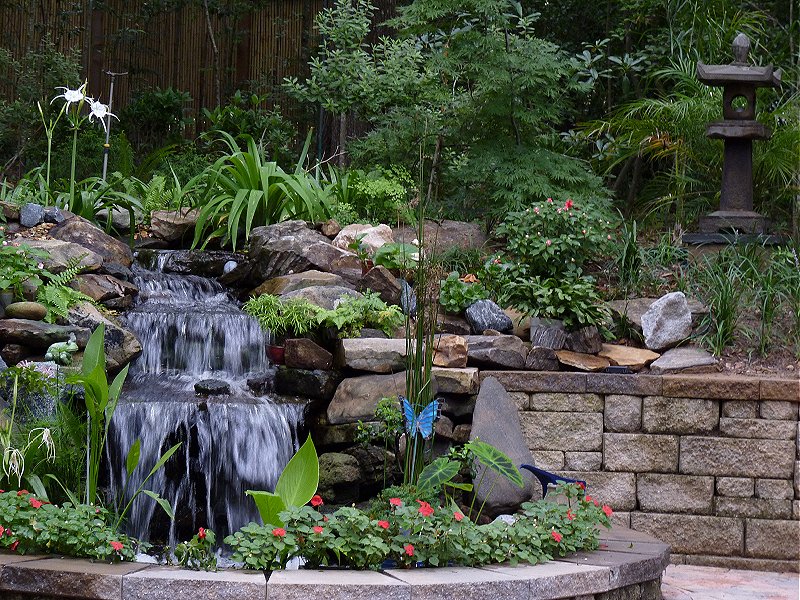 In my garden I planted 8 Japanese lace leaf maples, many azaleas, camellias, lilies, irises, ferns, lariope and mondo grasses, and other trees, shrubs, and plants. I also purchased and carefully situated six Japanese lanterns and a pagoda. I built a number of items such as Japanese Kyoto-style bamboo screens (kenninjigaki), a long stone path that meanders throughout the garden, an upper-garden water feature that includes a babbling brook meandering around a small island, a white gravel meditation garden with a bench for viewing the island, an 8-foot red “moon” bridge that crosses the brook, a torii gate that supports a covered pergola (I call it a “toriigola”), a garden entrance gate in Japanese style, two stone water basins (chozubachi) with bamboo spouts (kakei), and a rock garden with three boulders set in a scalene triangle. I added many goldfish and shibunken in my lower pond, and they constantly threw us kisses, telling me that they are always hungry, until they were eaten by a raccoon or hawk.
In my garden I planted 8 Japanese lace leaf maples, many azaleas, camellias, lilies, irises, ferns, lariope and mondo grasses, and other trees, shrubs, and plants. I also purchased and carefully situated six Japanese lanterns and a pagoda. I built a number of items such as Japanese Kyoto-style bamboo screens (kenninjigaki), a long stone path that meanders throughout the garden, an upper-garden water feature that includes a babbling brook meandering around a small island, a white gravel meditation garden with a bench for viewing the island, an 8-foot red “moon” bridge that crosses the brook, a torii gate that supports a covered pergola (I call it a “toriigola”), a garden entrance gate in Japanese style, two stone water basins (chozubachi) with bamboo spouts (kakei), and a rock garden with three boulders set in a scalene triangle. I added many goldfish and shibunken in my lower pond, and they constantly threw us kisses, telling me that they are always hungry, until they were eaten by a raccoon or hawk.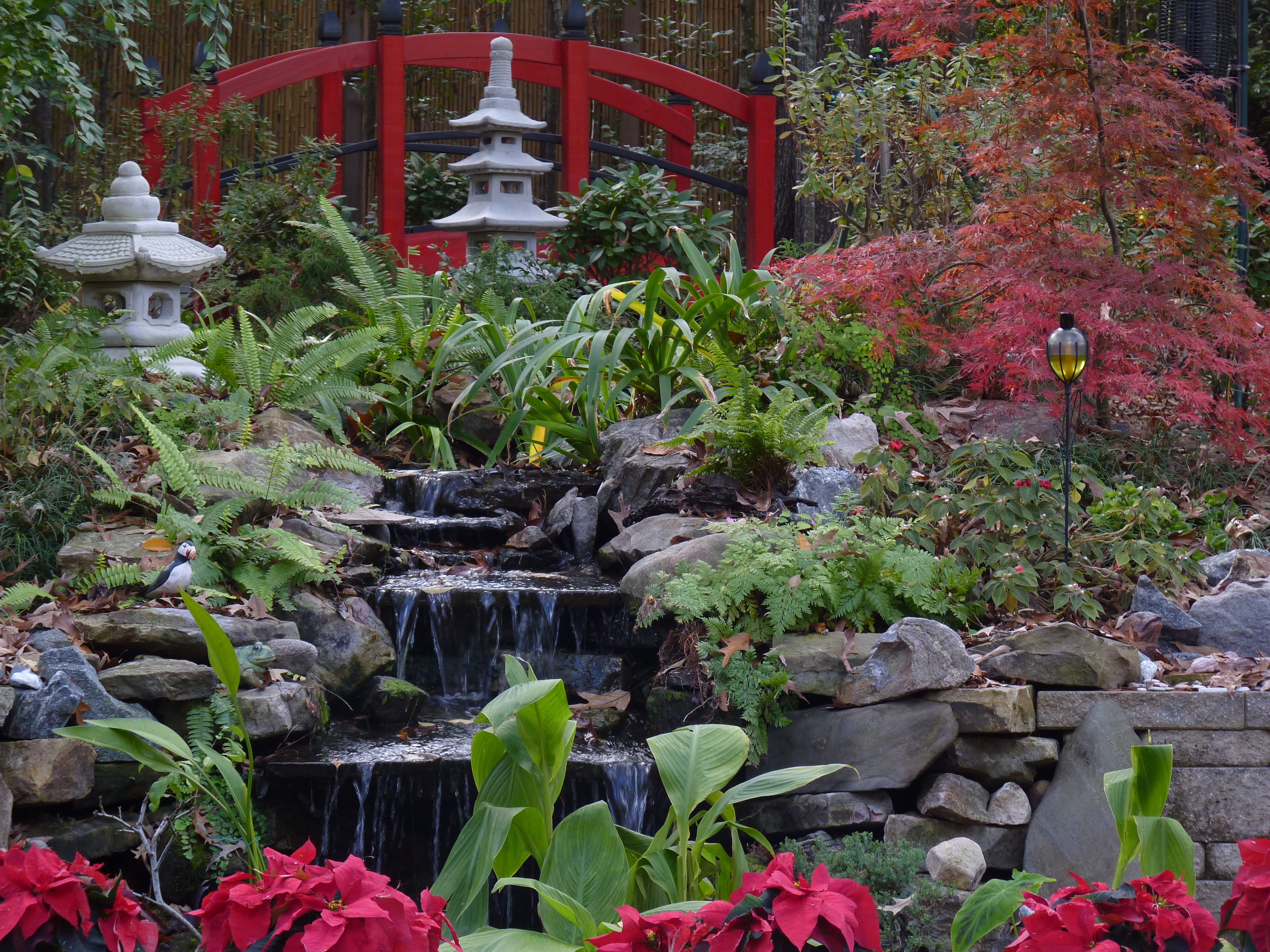 The patio, entered from our house through the torii gate, is a great place to have parties, to cook out, and just relax. From there you can take a stroll along the stone path and enjoy the miegakure or visual surprises that occur at various strategic spots. Most importantly for me, it is an on-going project that gives me great pleasure, comfort, and some light exercise.
The patio, entered from our house through the torii gate, is a great place to have parties, to cook out, and just relax. From there you can take a stroll along the stone path and enjoy the miegakure or visual surprises that occur at various strategic spots. Most importantly for me, it is an on-going project that gives me great pleasure, comfort, and some light exercise.
For real exercise I enjoy bicycling during the spring, summer, and fall, and hiking during the winter. Tallahassee has many wonderful greenways and wooded trails, paved bicycle paths, mountain bike trails, and other areas for extensive bicycling and hiking (or just plain walking).
Now, in 2021, with covid-19 still a threat (we are completely vaccinated), and remain homebound for the most part. Di continues to swim twice a week, we ride our bicycles, we work in garden, we play music a lot, and do other things by ourselves or by Zoom. We rarely see our family in Georgia, do not travel to Minnesota anymore, and have stopped cruising and traveling. We pray for healing in our country and world, and we wait patiently for life to return to normal.


